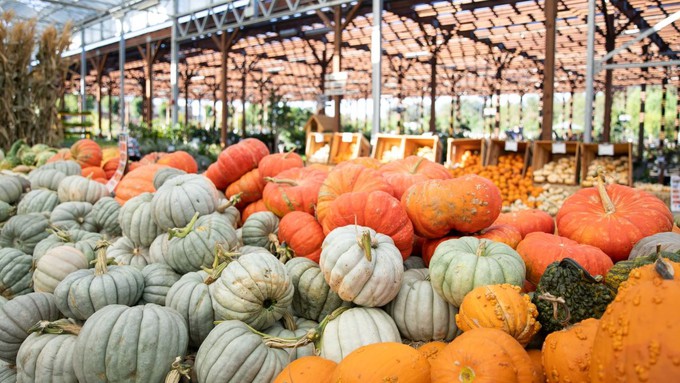
Patches now open at local nurseries; what to look for when pumpkin shopping

Just in time for Green Acres' annual Fall Festival, piles of pumpkins await shoppers at Green Acres Nursery & Supply. Photo courtesy of Green Acres Nursery & Supply www.idiggreenacres.com
It’s pumpkin time, as evidenced by brightly colored piles outside supermarkets and inside nurseries.
But how do you choose the perfect pumpkin? It depends on what you’re shopping for.
Most pumpkins now rolling into stores are for Halloween carving or decorative purposes. Most carving pumpkins – bright orange with thin rinds and smooth skin – are hybrids of Connecticut field pumpkin varieties – the classic heirloom pumpkin. It tends to weigh 15 to 20 pounds, giving these future Jack-o-lanterns some size but not too much heft.
Pumpkins with thin rinds or walls tend to be easier to carve than thick-walled varieties. How can you tell before you crack it open? Pick it up; does that pumpkin seem heavy for its size? If so, it’s thick walled. Also, look at the stem. Thick-walled pumpkins tend to have hefty, thick stems.
Thin or thick, choose a pumpkin that feels solid to the touch all the way around. Avoid any with soft spots or sunken areas; they’ve already begun to decay.
Fresh pumpkins can last several weeks if left uncarved and kept out of direct sun. But a carved pumpkin’s lifespan is mere days (if not less than 24 hours); those cut surfaces tend to mold or rot quickly.
Interest in uncarved pumpkins as fall decorations had led to a plethora of pumpkin varieties. For example, Green Acres Nursery & Supply stocks at least a dozen different varieties: Carving, Fairytale, Lumina, Lil’ Pump-Ke-Mon, Cinderella, Jarrahdale, Big Max, Cronus, Iron Man, Knucklehead, One Too Many and Lunch Lady plus mini pumpkins, winged gourds and gooseneck gourds.
Need carving and decorating ideas – or want to show off your own skill? As part of its Fall Festival on Saturday, Sept. 30, Green Acres is hosting a pumpkin decorating contest at each of its seven locations. Decorate and/or carve the pumpkin in advance and enter it before 9:30 a.m. at the store’s contest table. Categories include Scariest, Silliest and Most Creative. Winners will be announced Monday, Oct. 2.
Green Acres’ Fall Festival also includes pumpkin-inspired games, crafts and workshops including how to turn a pumpkin into a succulents planter. Festival hours are 9 a.m. to 4 p.m. Saturday; admission and parking are free.
Green Acres is located in Sacramento, Auburn, Citrus Heights, Elk Grove, Folsom, Rocklin and Roseville. For addresses, directions and more details on the Fall Festival: https://idiggreenacres.com/.
Comments
0 comments have been posted.Sacramento Digs Gardening to your inbox.
Sites We Like
Garden Checklist for week of July 21
Your garden needs you!
* Keep your vegetable garden watered, mulched and weeded. Water before 8 a.m. to reduce the chance of fungal infection and to conserve moisture.
* Feed vegetable plants bone meal, rock phosphate or other fertilizers high in phosphate to stimulate more blooms and fruiting. (But wait until daily high temperatures drop out of the 100s.)
* Don’t let tomatoes wilt or dry out completely. Give tomatoes a deep watering two to three times a week.
* Harvest vegetables promptly to encourage plants to produce more. Squash especially tends to grow rapidly in hot weather. Keep an eye on zucchini.
* Pinch back chrysanthemums for bushy plants and more flowers in September.
* Remove spent flowers from roses, daylilies and other bloomers as they finish flowering.
* Pinch off blooms from basil so the plant will grow more leaves.
* Cut back lavender after flowering to promote a second bloom.
* It's not too late to add a splash of color. Plant petunias, snapdragons, zinnias and marigolds.
* From seed, plant corn, pumpkins, radishes, winter squash and sunflowers.